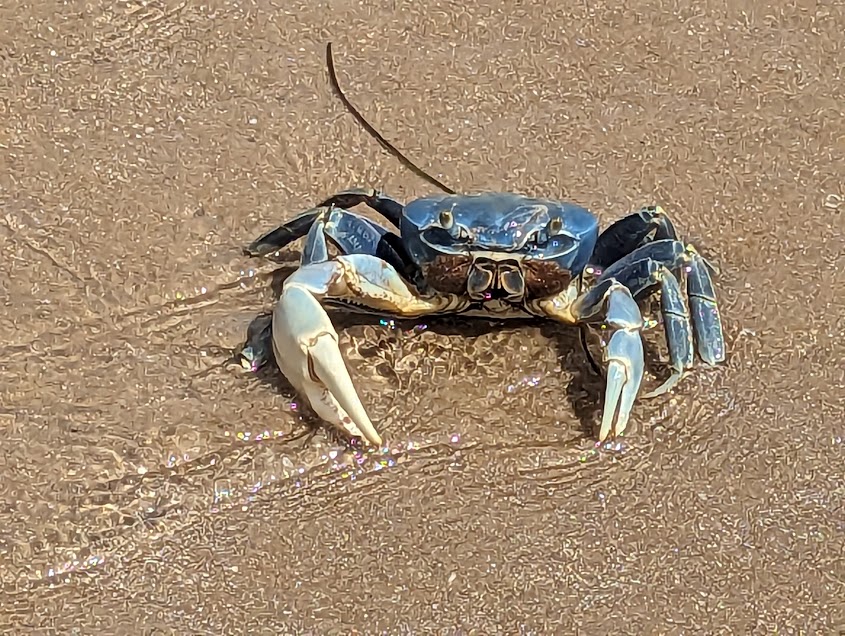A man on the beach gesticulated so wildly that I imagine the driver for Cameron County Beach Patrol, veering towards him, feared that someone was drowning, stung or, heaven forbid, bitten.
But, no, the man sought to protect a beautifully adorned blue land crab crawling along the sand, coaxing it—using a plastic bucket as prod and container—back into the surf. This worked—till waves promptly plopped it back onto the shore.
At first, I mistook this large, lovely blue land crab (Cardisoma guanhumi) for the coveted blue crab so many locals seek. I was unaware that Texas—which boasts 14 crab species—housed similarly large ones.
The blue land crab has a lovely bluish tint, but, unlike the blue crab, its chelipeds, or claws, are not blue but whitish, with one much larger than the other, like those of fiddler crabs. The land crab’s oversized claw, used especially by the male for defense, can regenerate if lost, while the smaller claw makes do in the interim.
This crab—also called land crab or great land crab—reaches a width and length of about 4 ½ and 4 inches, respectively. The slightly smaller female has a larger, wider abdomen suited to carrying egg masses. During molting, both may become bluer, and during mating season, a female may become deeper blue, violet or even tannish. Juveniles are tan or brown and have orange legs. Being crabs, they have a cephalothorax (fused head and thorax) and five pairs of appendages carpeted in tactile setae, or hairs, and stalked eyes.
I enjoy fleeting glimpses of these colorful creatures at the South Padre Island Convention Center when, at my approach, they bolt into their burrows—sometimes cautiously creeping out, then, noting my presence, scurrying back in. In muddy sand, often among mangroves, a crab excavates dirt with its large claw, creating a burrow that extends at an angle of from 25-50 degrees, then, widening, descends steeply to from 3 to 5 inches, its base filling with groundwater. During cold spells, the crab plugs the burrow’s mouth and stays inside.
This crab may live up to five miles from the seashore, facilitated by its large epibranchial, or gill, chamber that increases the volume of air exposed to its gills. It can survive three days out of water, but it dampens its gills with water from its burrow.
Blue land crabs, native to the Gulf of Mexico and the Atlantic from Florida southwards to Brazil, have recently expanded their range, appearing as invasive species as far north as North Carolina, and residents worry about their potential harm. Sometimes a nuisance, these crabs may burrow in gardens and farmland, and some worry that groundwater at the bases of their burrows may attract disease-carrying mosquitoes. Especially after heavy rainfalls which flood their burrows, land crabs pop up in the yards of South Padre Island residents.
The blue land crab eats chiefly vegetation, including mangrove leaves, grass and fruits, but also insects and carrion, all of which it crushes and tears with its claws. It may carry morsels to its burrow to snack on later. Since the crabs sometimes cannibalize one another, those who catch and market them often segregate the smaller crabs.
Typically, these crabs breed once annually, most often in spring and summer, based on lunar cycles and weather patterns. A female, who can mate by about age four, releases pheromones to attract a male, who in turn, courts her, and they copulate outside their burrows. A female lays an average of about 370,000 eggs, which she totes on her back for from ten to twelve days till she and other females amass and migrate into the sea. She fans her abdomen to release newly hatched larvae, which—if not consumed as plankton—undergo five stages before turning into little crabs and coming ashore.
Throughout the Caribbean and Central and South American coasts—as well as in southern Florida and parts of Mexico—people eagerly catch and eat blue land crabs. In fact, Puerto Rico has enacted strict laws to prevent their depletion. Local writer Eduardo del Rio, who grew up in Puerto Rico, recalls people shining bright lights on crabs, then caging them and feeding them scraps to clean their systems. So common is crab hunting in Puerto Rico that he and others of his generation fondly recall the catchphrase “Ciégalo, Toño!” from an old Eveready battery commercial—instructions to Toño, or Tony, to blind a crab with a bright light. Today, del Rio says, “You can go to a tourist area along the beaches of Puerto Rico and buy fried food stuffed with that crab meat.” Blue land crab cuisine—including such prized delicacies as salmorejo de jueyes (land crab stew) and alcapurrias de jueyes (crab-stuffed fritters)—has apparently not caught on in our country.
Following is an excellent video on blue land crabs by Jace Tunnel of the Harte Research Institute for Gulf of Mexico Studies at A&M Corpus Christi:

